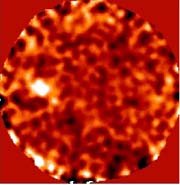
Until now, scientists thought that only specially adapted organisms they call extremophiles could exist in seemingly intolerable environments such as high-pressure, high-temperature oceanic hydrothermal vents or in the ice sheets of Antarctica. A study published in the February 22, 2002, issue of Science, however, shows that even common bacteria are viable under high-pressure conditions equivalent to about 50 kilometers beneath the Earth’s crust or 160 kilometers in a hypothetical sea. This finding may expand the habitable zone for life within the solar system and it opens new doors for looking for life much deeper inside planetary bodies than previously considered. According to Dr. Anurag Sharma the lead author, “It is exciting to observe the microbes under such unusual environments. Their continued biological activity says a lot about their resilience.” The scientific team is headed by Sharma and James Scott at the Geophysical Laboratory of the Carnegie Institution of Washington. They adapted the tools of high-pressure physics to microbiology by using diamond anvil cells to subject two bacteria species–E. coli commonly found in the human gut, and the metal reducing Shewanella oneidensis–to pressures up to 16 thousand times the pressure found at sea level. “This is a very high-pressure condition for biology. Since liquid water turns into a solid high-pressure ice even at room temperature, these conditions are typically considered inhospitable,” says Sharma.
The study suggests that as far as pressure goes, the subduction zones on Earth and deep water/ice structures, such as those found on the moons Europa, Callisto, and Ganymede, might be environments that could harbor life. “Understanding how microbes survive deep subsurface environments expands our ability to define and examine potential habitable niches beyond Earth,” commented NAI Associate Director, Dr. Rose Grymes. The techniques being developed at the Geophysical Laboratory will be used to test various hypotheses on the viability and probability of life in different environments, even before any NASA missions for the search for life are planned. For some time there has been mounting evidence that a large portion, if not a majority, of life today exists in the deep subsurface (including in deep frozen lakes and the ice caps on Earth). This along with other recent findings should be taken into account when focusing on the survivability of life elsewhere. “Soon the only thing that should limit our investigation of the survivability of life on Earth and beyond is our imagination,” concludes Scott.

















Comments are closed.